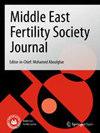Testicular sperm aspiration (TESA) outcome in Middle Eastern patients with non-obstructive azoospermia: a retrospective cohort study
IF 1.3
Q4 REPRODUCTIVE BIOLOGY
引用次数: 0
Abstract
Infertility is an important health problem, affecting couples worldwide. Non-obstructive azoospermia is the most severe form of azoospermia, which is mostly idiopathic or caused by different causes such as chemotherapy and genetic disorders. Testicular fine needle aspiration (or testicular sperm aspiration (TESA)) is simple, cost-effective and less invasive than testicular sperm extraction. Three hundred twenty Middle Eastern patients with NOA were recruited in this study. The patients underwent routine infertility assessment including medical, surgical, and reproductive history, physical examination, semen analysis, and hormonal profile including FSH, Testosterone, and inhibin B in addition to Genetic assessment including karyotype and Y-chromosome micro-deletion. Testicular sperm aspiration was positive in 70 patients (22.18%). Serum FSH levels were clearly elevated in the patients with negative sperm retrieval (mean = 21.39 U/L), while they were reduced in the patients with positive sperm retrieval (mean = 14.61 U/L). Testosterone value did not clearly correlate with the results of testicular sperm aspiration in the two groups of patients, and testicular volume was normal for most of the patients in the two groups. Patients with Y-chromosome micro-deletion were 11.22% of the total patients studied and they had negative TESA results, while 13.12% of patients had Klinefelter Syndrome and their TESA results were negative. We confirmed that there are many factors that negatively affect Testicular sperm aspiration results: high FSH and low inhibin B levels, smoking, and genetic disorders. Despite the absence of sperm in the semen, some NOA patients have a chance to have children by using this technique.中东非梗阻性无精子症患者的睾丸精子抽吸术(TESA)结果:一项回顾性队列研究
不育症是一个重要的健康问题,影响着全世界的夫妇。非梗阻性无精子症是最严重的无精子症,多为特发性或由化疗和遗传疾病等不同原因引起。睾丸细针穿刺术(或睾丸精子抽吸术(TESA))比睾丸取精术简单、经济、创伤小。本研究招募了 32 名中东无精子症患者。这些患者接受了常规不孕不育评估,包括病史、手术史、生殖史、体格检查、精液分析、激素分析(包括 FSH、睾酮和抑制素 B),以及遗传评估(包括核型和 Y 染色体微缺失)。70名患者(22.18%)的睾丸精子抽吸呈阳性。取精阴性患者的血清 FSH 水平明显升高(平均 = 21.39 U/L),而取精阳性患者的血清 FSH 水平则有所降低(平均 = 14.61 U/L)。两组患者的睾酮值与睾丸精子抽取结果无明显相关性,两组患者的睾丸体积大多正常。Y染色体微缺失患者占研究患者总数的11.22%,他们的TESA结果均为阴性,而13.12%的患者患有克莱恩费尔特综合征,他们的TESA结果均为阴性。我们证实,有许多因素会对睾丸精子抽吸结果产生负面影响:高 FSH 和低抑制素 B 水平、吸烟和遗传疾病。尽管精液中没有精子,但一些无精子症患者仍有机会通过这项技术生育子女。
本文章由计算机程序翻译,如有差异,请以英文原文为准。
求助全文
约1分钟内获得全文
求助全文
来源期刊

Middle East Fertility Society Journal
REPRODUCTIVE BIOLOGY-
CiteScore
2.80
自引率
0.00%
发文量
32
审稿时长
45 weeks
 求助内容:
求助内容: 应助结果提醒方式:
应助结果提醒方式:


